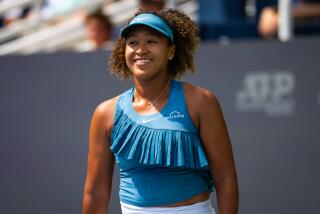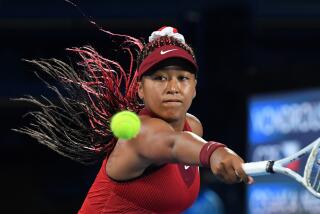Graf on Course for More Than a Grand Slam
- Share via
Steffi Graf is so utterly, charmingly 19 it is difficult to believe this same woman occupies the tennis courts of the world so adultly. Having embraced no concept more meaningful than fast food, she brusquely dispatches players whose careers are older than she is years. Moreover, this callow talent is threatening to win the ageless Grand Slam while still under parental supervision.
Graf lives at home, like most 19-year-olds with adventurous habits probably should. She has a 19-year-old’s impervious taste for plasticky drive-through cheeseburgers and greasy fries. She has a typical devotion to her stereo headphones and a preference for driving rock music that sounds like the thumpity-thump of ash cans rolling down a street. She has a loyal affection for her dog Max, even when he bites her, and she sleeps in the same room she did as a child.
She wears faded though not inexpensive jeans, casually beat up suede loafers and wrinkled though not unfashionable T-shirts that hang from her massive shoulders. Her walk is a youthful slump-and-lope, she tosses longish hanks of blond hair from a roundish face. She rolls embarrassed blue eyes and ducks her head when confronted with these issues of her unseemly youth, wealth and talent. “I feel my age,” she shrugged. “Maybe in a way I’m older, but I feel 19.”
But Graf’s occupation is admittedly not one normal for late teendom, which is to be expected because no other 19-year-old has the opportunity to sweep the Grand Slam tournaments in the same calendar year when the U.S. Open began Monday at the National Tennis Center in Flushing Meadow, N.Y. There, Graf can collect the final trophy in the historical collection that includes the Australian and French opens and Wimbledon.
Graf would become only the fifth person to do so, and the first woman since Margaret Court in 1970 (the others are Don Budge, 1938; Maureen Connolly, 1953; and Rod Laver, 1962 and 1969). There is the sensation that should Graf do it, she could dominate the game for the next decade, because she has lost exactly one set in taking the first three legs of the Slam, on the grass of Australia and Wimbledon and the clay of Roland Garros, which aren’t particularly her best surfaces. The hardcourt of the Open is. What is more staggering than her chance at the Slam is the potential breadth of her game and the idea that she could get much better.
“She says she still won’t play her best tennis for two or three years,” said her coach, Pavel Slozil. “That’s really the goal, to satisfy the game.”
Graf, still unable to measure herself as a person or player, cannot be expected to grasp what it would mean to win a Slam so early in life. In Australia she giggled when they asked her the question, and in France she shrugged. After Wimbledon, it was no longer a laughing matter but a pressing issue and, the tone of her voice sometimes suggests, it was apologized for.
“I didn’t think it, I really didn’t,” she said. “Everybody was already asking me about the Slam after Australia, and I said, ‘Well, I’m the only one who can do it now.’ But I couldn’t believe it, I was laughing.
“I think it’s probably the best thing you could ever do. You might not realize it when you do it, but a couple of years later, you would. It’s the biggest thing.”
There exists the comical possibility that Graf could win the Grand Slam while she is still growing. She got a centimeter taller this year, which brings her to 5 feet 9 and 130 pounds of destructive force. Graf’s game itself might be described as “the biggest thing,” a massive driven entity that has kept pace with her physical growth.
Her father, Peter, a tennis coach from Bruhl, West Germany, put the first racket in her hand when she was 4, after sawing off the handle. By the time she was 12 she was playing adult tournaments internationally, setting a record she still holds for the youngest player ever to be ranked on the WITA computer. At 15, she won the gold medal in the 1984 Summer Olympics (tennis was a demonstration event) in Los Angeles, in the same year becoming the youngest player to reach the Wimbledon quarterfinals.
Graf’s hectic rise occasionally suggested that she was too driven, a child prodigy of a demanding father-coach. Her quietness combined with the constant presence of her father on tour as her chaperon for a time gave her a reputation as aloof, particularly after incidents like the 1986 U.S. Open, when she stormed past a consoling Martina Navratilova after losing a semifinal.
But as Graf has become older and more articulate, it has become evident that if anyone was doing the driving, it was the child. To suggestions that perhaps she has missed a more normal life, she replies, “Are you sure? I have to say I’ve never missed anything. I do everything I want.”
Peter Graf has emerged as a affectionate, protective father who views himself as a buffer for any criticism of his daughter. If he has played a role in her success beyond coaching, it has been forcing her to take a few days off to do things like go water skiing in Marbella, Spain, and maintaining the most normal home possible under the circumstances. She chooses to live at home in Bruhl rather than buy her own place because, she shrugs, “It isn’t necessary (to move out) yet.”
“I’m not a person who likes to have the racket out of her hand,” she said. “Someone has to say stop. My father has been a big part of that.”
So, if anything pushes Graf, it is her own obsessive lust for playing tennis. There is an odd sense that she doesn’t play for money or victories so much as the sheer sensation of hitting the felt cover off the ball. She hasn’t bought anything with her money, beyond a plain car and a new Sony Walkman. “It’s nice to know I’m secure,” she said. “But I’m not spending my money on crazy things. I never will. I’m not that kind of person.” Her titles are just so much coal for the furnace, tournaments merely an excuse to pull Slovil onto the practice court.
“I think I never met someone who loves the game more than she,” Slovil said. “It’s never happened yet that I said, ‘It’s time to go practice.’ Until she is late or doesn’t want to go out there, I’ll have to say she loves the game more than anyone.”
She plays with a sort of brevity, an impatience that seems almost dismissive of her opponents. She has a cold, unfeeling backhand and an injurious forehand that might the single hardest stroke around, along with her right-handed serve. She carves out whole swatches of open court, leaving the opposition humiliatingly vulnerable to easy volleys. “Sometimes,” she said, “if my opponent is easy or not playing well, I get a little angry because I wish they would play better.”
But Graf is not callous so much as she is intent on her own purpose; she seems to greet every stroke with the sentiment, “Look, a ball!” In the Australian, she whipped Chris Evert in the first set, 6-1, and had her down by 5-1 in the second before Evert lost respectably, 7-6. In the French, she defeated Natalia Zvereva by 6-0, 6-0 to complete the first shutout ever in a final at Roland Garros. “I was blown out,” Navratilova said incredulously after her three-set loss in the Wimbledon final, in which Graf took 12 of the last 13 games for a 5-7, 6-1, 6-2 victory.
Graf has brought sheer power to women’s tennis, much in the way Navratilova first brought pure athleticism to it. She is threatening to develop the sort of thrall Navratilova held over the game when she won six straight grand slam events in 1983 and 1984 (she did not win a Grand Slam because the four did not come in a calendar year). Graf has held the No. 1 spot without interruption since August of last year, and has now won four grand slam events in the last 13 months. She has played in six straight grand slam finals and won four.
The turning of the tide is now painfully evident to the 33-year-old Evert and 31-year-old Navratilova, both of whom acknowledge they won’t be in the game much longer. “I’ll be back next year if my aching body holds up,” Navratilova said at Wimbledon after Graf halted her streak of six straight titles. As long ago as last year’s U.S. Open, Evert had already delivered her benediction. “I think a lot of people wondered what would happen when we retired, and now they don’t wonder anymore,” Evert said then. “Steffi will be a good No. 1 for women’s tennis.”
There is one significant drawback to Graf’s tennis idyll, however, and it is fame. She sometimes flees to her second home, a condo in Boca Raton, Fla., because going back to West Germany has turned into an unrestful strain since becoming a national hero there. They drive slowly by her house, knock on the door for autographs, demand her opinions on international matters. She longs for some small amount of time in which to enjoy her accomplishments before the clamor for more begins.
“The tennis,” she said, “is much easier than what’s around it.”
But as her victories increase, the problem compounds, and she remarks dolefully on the fact that her interview commitments now take take more time than her matches. Those have become a sort of refuge, where she can play with a sort of unthinking nervelessness that perhaps only a 19-year-old possesses.
“It’s very difficult to do it right for everybody,” she said. “If you play fast, they say you are too fast. But once I got down, 3-0, and someone said they wanted their money back. They don’t know what they want. So I do it for me, I do what I want and what’s best for me.
“I don’t really like not having so much time. Like when you win Wimbledon, you can’t really do what you feel. A few years ago, I could feel it much more. Now, I have to worry about winning the next tournament.”
There is a “next tournament” at the Summer Olympics in Seoul (tennis is reinstated as a medal sport this year), where Graf is expected to win another gold medal, and she will have just three days to get there from New York. But for the moment, the next tournament is the Open, and that means the Slam. Graf has questoned Court about it, and received an interesting reply: “She says not to think about it too much.”
More to Read
Go beyond the scoreboard
Get the latest on L.A.'s teams in the daily Sports Report newsletter.
You may occasionally receive promotional content from the Los Angeles Times.










